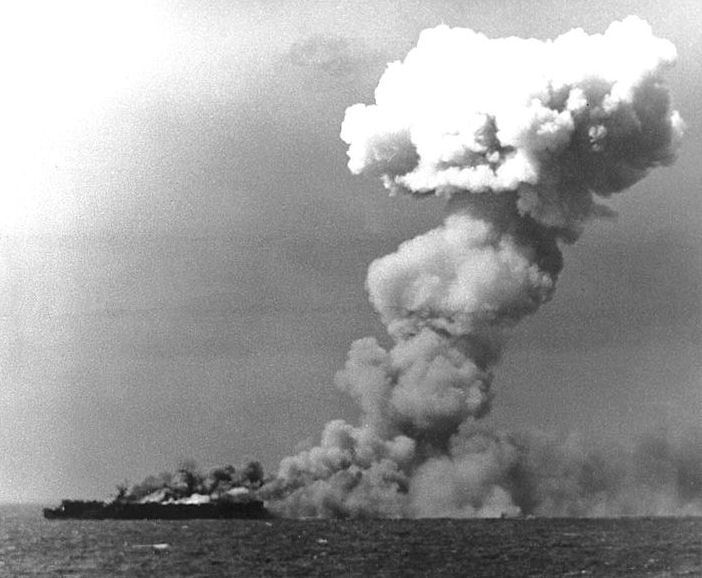*Image Credit: Wikimedia Commons Spanning some 200 miles around the Philippine Islands, the Imperial Japanese Navy (IJN) retreated from the United States’ 3rd and 7th Fleets to end what is widely considered the largest naval action in history on October 26, 1944. Famous for a variety of reasons, the Battle of Leyte Gulf marked the end of the IJN’s ability to move as a large-scale battle group. For the better part of two years, the combined Allied force in the Pacific Theater methodically rolled back the Japanese advance. Under threat since August 1942 and suffering as the American Navy secured an increasing number of strategic locations in its island hopping campaign, Japanese leadership decided the IJN would strike back in mid-June 1944. In the Battle of the Philippine Sea, the US’ 5th Fleet repelled the counterattack and sank three aircraft carriers, eliminating upwards of 600 planes in the process. In a bid to secure the region for Allied shipping and land operations, General Douglas MacArthur convinced his colleagues at the head of the Navy battle groups, Admiral William Halsey (3rd) and Vice Admiral Thomas Kinkaid (7th) to help him land an invasion force on the Philippine island of Leyte. In order to soften the resistance, Halsey directed his pilots to launch a distraction at Formosa (modern Taiwan) and on the Ryukyu islands early in the morning of October 12, 1944. American fighters, routing their Japanese counterparts, managed to cripple the IJN Air Service and reduce the number of experienced pilots available even further — a victory with stunning consequences at Leyte Gulf. Though referred to as one battle, the conflict near the Philippines amounts to four separate engagements in quick succession — Sibuyan Sea, Surigao Strait, Samar and Cape Engano. Shortly after midnight on October 23rd, first contact was made. American submarines detected a Japanese battle group moving past Palawan Island, securing a firing solution shortly before dawn and managing ten hits on three of the IJN’s heavy cruisers. Two of the ships dropped below the surface quickly, with the third nursed back to port in Singapore defended by two destroyers. The rest of the IJN’s Central Force pressed forward to Sibuyan Sea. The following morning, American bombers swept in from the USS Intrepid and USS Cabot. With little air support, the Mushashi and Myoko suffered heavy damage. Japanese fighter planes from Luzon, called in to provide cover, were quickly intercepted. Though limping, the Central Force battle group managed to sneak outside the range of the 3rd Fleet’s aircraft, moving to the north toward Samar to join an undiscovered decoy force through the night of the 24th. As October 25th dawned, the battle opened up on two fronts. The IJN’s Southern Force moved in from Surigao Strait just as the Central Force began to work around the northeastern coast of Samar. The two opposing forces now split loosely into a destroyer-versus-destroyer engagement in the former (the last of its kind in history) and a carrier-versus-carrier battle in the latter. Attempting to defend the Philippines, the Americans managed to maintain defensive positions and use superior airpower to unhinge the IJN attack. Unable to make the breakthrough in either case, both lines of the Japanese assault pulled back. As the Central Force peeled off the 7th Fleet, Vice Admiral Takijiro Onishi unleashed a Special Attack Force. After addressing an inexperienced group of pilots — replacements for those killed during the Battle of the Philippine Sea and at Luzon two weeks earlier — Onishi ordered them to make a noble sacrifice in the cause of their homeland, unleashing the first organized wave of kamikaze pilots in World War II. The USS St. Lo, an escort carrier, took a direct hit and sank. At the same time, the IJN Northern Force — the one originally sent to draw out the American Navy — had yet to really see combat. Stationed near Cape Engano, some of its fighters had been sent out to attack the 3rd Fleet early on the 25th. Most of the aircraft were turned aside by American planes, with many of those that survived so damaged they were forced to take refuge at Luzon. With the IJN scrambling and elements of the 3rd Fleet in pursuit, Halsey ordered a withdrawal to secure the 7th Fleet. Near midnight, the submarine USS Jallao sank the Tama, ending the Battle of Leyte Gulf with the exception of a few air strikes on October 26, 1944. The US Sixth Army, led by MacArthur, could now advance on the Philippines without fear of an IJN attack from the sea. Through the course of three days, some 275 ships, over 1,500 aircraft and nearly 200,000 men had participated in the four engagements that made up the Battle of Leyte Gulf. Some of the Japanese ships, lacking adequate fuel to be sent into the field again, could not leave port before the Japanese surrender in August 1945. Also On This Day: 1597 – Korean Admiral Yi Sun-sin uses just 13 ships to defeat a 300-strong contingent of the Japanese Navy at the Battle of Myeongnyang 1775 – King George III of England stands before Parliament to declare the American colonies in rebellion 1881 – The Gunfight at the OK Corral takes place in Tombstone, Arizona 1947 – The Maharaja of Kashmir agrees to join the nation of India 1984 – Stephanie Fae Beauclair, known as “Baby Fae,” receives a baboon heart and becomes the first infant to be part of a transplant between species
October 26 1944 CE – The Battle of Leyte Gulf Ends
*Image Credit: Wikimedia Commons Spanning some 200 miles around the Philippine Islands, the Imperial Japanese Navy (IJN) retreated from the United States’ 3rd and 7th Fleets to end what is…
441
